Tremolos, Whammy or Vibrato Bars? A tale on tailpieces!
Tremolo vs Vibrato: So what's the Difference?
Tremolos, vibratos and whammy bars are somewhat interchangeable names these days, as order sometimes emerges from chaos. You can certainly say that’s what happened to the naming of an iconic guitar component whose game-changing contribution to the guitar sound is sometimes muffled in the cacophony of other interesting titles.
Despite its ancient origins, you can say that history has not always been kind to the venerable bar, as it will go down in it with yet another, much less flattering moniker: a whang bar. Yes, we are talking about… take a deep breath, the whammy bar, or if you prefer, vibrato arm/bar, twang bar, wiggle stick, vibrolas, silver straw, sterling spaghetti but most popularly, the tremolo bar.
The variety of terms used to describe this guitar component hints at its rich history and development, reflecting not only its diverse sounds but also its evolution over time. If names define identity, the tremolo bar embodies a paradox in its nomenclature. Here’s a straightforward explanation of Tremolo vs Vibrato:
Tremolo and Vibrato are two distinct musical techniques that are often mistakenly interchanged, particularly in the context of guitars. Tremolo refers to a rapid, repeated fluctuation in volume, creating a trembling or wavering effect in the sound. This can be achieved either through rapid picking or by using a tremolo arm on certain guitar hardware, which modulates the volume dynamically. On the other hand, vibrato involves a periodic variation in pitch, adding expressiveness and depth to a single note by slightly bending the string up and down. In the realm of guitar hardware, the terminology can be confusing—for example, devices like the Floyd Rose are commonly called tremolo systems, but they actually produce vibrato effects by allowing players to manipulate the pitch of the strings. Understanding the fundamental differences between tremolo (volume variation) and vibrato (pitch variation) is essential for musicians to effectively utilize these techniques and achieve the desired emotional impact in their performances.
tremolo [trem-uh-loh] A wavering effect in a musical tone, typically produced by slight and rapid changes in the volume (amplitude) of a note.
vibrato [vih-brah-to] A rapidly repeated slight change in the pitch (frequency) of a musical note.
While we acknowledge that the correct term for this device is “vibrato,” the misnomer coined in the 1950s by pioneer Leo Fender has developed a distinct identity of its own over time!
(To read more in-depth, check out Fenders: Difference between tremolo and vibrato article)
So, despite the fact that tremolo modulates the pitch instead of volume, the incorrect term stuck on and it still reverberates (pun intended) in both colloquial usage and musical literature. So how the heck did we get here?
Fender, we have a problem!
Many attribute this linguistic confusion to events in the mid-1950s when Leo Fender named his version of a vibrato the “Synchronized Tremolo.” While some speculate it was a marketing tactic to distinguish Fender from the Bigsby vibrato system, others argue there’s more to the story. Here’s a deeper look.
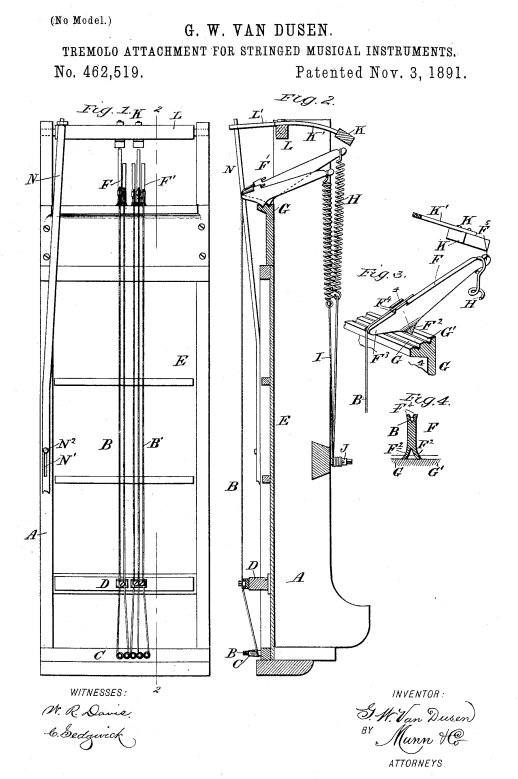
What’s important about this is the fact the word “vibrato” isn’t used once in the patent claim. But what’s also interesting is that this particular patent has been cited, or compared to, by 3 other inventors since that time. Emmons Guitar Company, Floyd D Rose, and you guessed it, Clarence L Fender.
So, one could argue that the name was botched well before the turn of the century and good old Leo along with his attorneys were just following suit. One could also argue that Fender cloaked themselves in a tremolo “shield” to avoid any infringement lawsuits with the boys over at Bigsby or anyone else using the term vibrato to protect their patents. However, this was just one facet of what contributed to the tremolo bar earning its esteemed reputation.
So where did Whammy Bar come from?
Another moniker it’s often associated with is the whammy bar. But why? While its naming history may seem less intricate, it’s certainly not lacking in colorful anecdotes. Experts and historians tend to agree on the theory that the term “whammy” in “whammy bar” was inspired by the sound Lonnie Mack achieved when manipulating the pitch in his 1963 song “Wham!”. The tremolo bar in this song produces a bold and almost aggressive sound. Interestingly, while the famous song ended dramatically, it’s possible that the tremolo bar originally aimed to emulate the softer, sliding sound of a Hawaiian steel guitar.
Going Beyond the Hawaiian Sound

The Vib-Rola invention needed to generate revenue quickly, so Epiphone acquired the distribution rights and bundled the novel device with its acoustic guitars. Rickenbacker wanted to go electric and soon purchased the rights to install this early version on its lap steel and Electro-Spanish models. However, the Vib-Rola rose to mythic status in the pantheon of electric music only after John Lennon played his Rickenbacker 325 to conquer the pop-rock world (and countless female hearts) in the early 1960s.
Trailblazing the Golden Age
The Vib-Rola’s unpredictable pitch return proved to be its downfall, dooming Doc’s tremolo bar design in the eyes of history. This set off a tremolo design “space race” among guitarists and inventors in the 1960s, running parallel to the actual space race. Each camp pushed the tremolo bar (vibrato) in their own direction as they tried to please corporate suits. The resulting tremolo bar redesigns were many, but luckily none undermined the core purpose.
But it was one particular variation on the tremolo theme which would ultimately usher in the era of its mainstream popularity. Powered by imagination and the musicians’ desire to find the proverbial philosopher’s stone when it comes to their desired sound. Yet, the Golden Age could not begin without the tremolo going big in terms of both its technology and mass production.
Go Bigsby or Go Home: Tremolos for the Masses
The answer came with appropriately named Bigsby Vibrato, designed by Paul A. Bigsby who wanted to cure all the imperfections plaguing earlier models and offer a pleasurable playing experience in the process. Once guitar players felt comfortable enough with this piece of hardware, they could start creating a vast array of spell-like effects with their tremolo bars, ranging from subtle, shimmer-like additions to the sound to dive bomb effects which came much later. Remember that this was 1951, the year in which guitar acrobatics were yet to find their virtuoso prophets in the body & mind of Jimi Hendrix and his epigones.
For now, this late 1940s design by Bigsby had the tremolo perform the task of loosening the strings. To that purpose, these tremolos were put on the guitar surface, with the strings fastened around movable metal bar. From there, the strings went over the rocker bridge on the surface of the instrument, while being attached to the metal bar holding the tremolo itself. Counterweight to the bridge was provided by the spring – the pitch was lowered by slackening the strings which, in turn, is achieved by pushing the tremolo bar forward. Upon release, the tailpiece reverted back to its starting position, usually.
Legend says that Bigsby’s original intention was to improve on Doc Kaufmann’s Vibrola design, which he eventually did, by actually starting all over and offering a brand new design. His patent was issued in March 1953 simply titled TAILPIECE VIBRATO FOR STRING INSTRUMENT. Yet, it seems as if old Doc had his belated revenge on the competitor, as Bigsby’s design suffered from some similar serious flaws, chief among them being the high probability of putting one’s instrument out of tune with the use of the tremolo. Despite the relative ease with which one could handle the bar, its limited downward range of movement made reverting back to the original pitch quite a feat, which increased the risk of diluting the tone itself. In addition to this, the guitarists had to correctly assess the level of friction created at the bridge and the nut, making their job at carving out the perfect sound even harder. If a limited downward range and unpredictable pitch return wasn’t bad enough, pulling the tremolo bar it up would sometimes result in the total detachment of the instrument’s return spring.
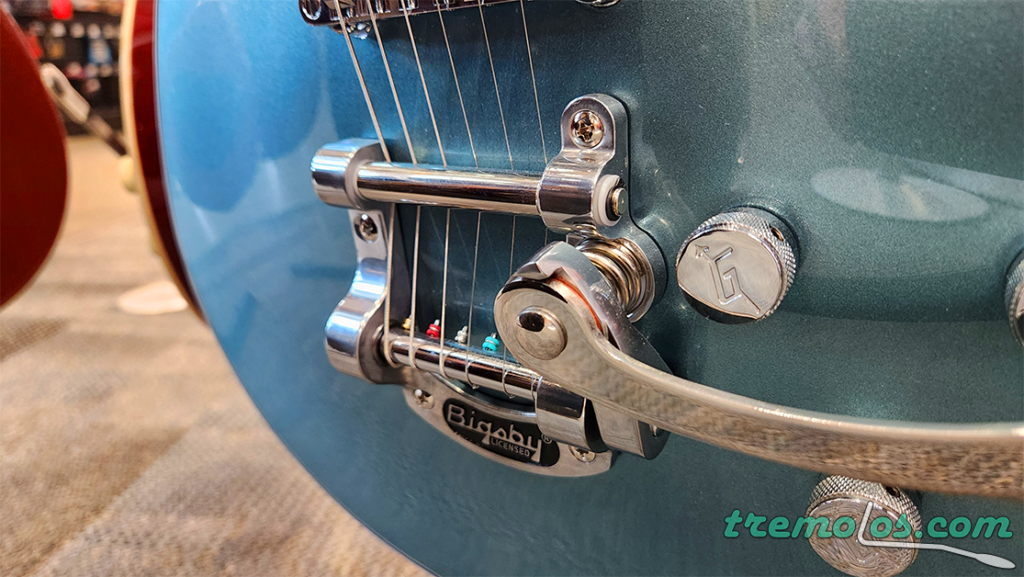
The style became popular among surfers, country music fans, and rockabilly enthusiasts of past eras and the current age. Just check Duane Eddy’s fuzzy Bigsby-powered chords in Movin’ n’ Groovin’ and try to resist being immersed in the sweet molasses of nostalgia and early tremolo recordings’ groove. Being nostalgic about it or not, the credit should be given when it’s due and you can certainly say that Bigsby’s name will be carried on the sound waves of its tremolos in days to come.
Checkout this blog on: Bigsby,The Classic Guitar Vibrato Bar.
Tremolo with Strat and Swagger


First of all, Fender’s tremolo was not called “synchronized” in order to provide it with a flashy marketing name, as it offered the integration of the bridge and tremolo itself. Once assembled, the entire piece would be placed on the guitar belly-mounted down with 6 wood screws.

Staying Afloat
In essence, Fender had to change the design philosophy of its new floating tremolo system and matching floating bridge in order to stay in business. Although Stratocasters are now considered cultural icons, in the 1960s they were underdogs compared to other models, even among Fender’s own guitars. Fender’s counterattack on tuning stability began with the launch of the high-end Jazzmaster (1958) and Jaguar (1962) models. The tuning mechanisms of these models incorporated new features that greatly improved stability.
The Stratocaster guitar model experienced a surge in popularity as a simpler and more affordable option compared to other models. Emerging champions of guitar playing, such as Jimi Hendrix, Jeff Beck, and Pete Townshend, celebrated and popularized the Stratocaster. Meanwhile, Fender briefly withdrew the Jazzmaster and Jaguar models from the market in the early 1970s. These models would not return until the 1980s when interest in them was revived.
The original Jazzmaster featured a six-saddle bridge and a new tremolo system with a locking slider to help keep the instrument in tune. This replaced the previous synchronized tremolo design with a more complex but slightly less accessible mechanism. The tremolo springs were accessed by removing the back plate of the guitar, and the entire tremolo assembly sat on a triangle-shaped front plate opposite the bridge. A short coil spring provided compression to balance the tension from the tremolo springs, adjustable via a screw in the center of the plate.
The Jaguar capitalized on the popularity of the Jazzmaster and its floating tremolo design. Fender promised players that both models would be a blessing if used properly per the manuals. However, guitarists of the era were not inclined to follow rules. They handled their instruments as they wished, even if it meant sacrificing Fender’s promise that the new floating tremolos would stay in tune better than past models.
The Stratocaster guitar model experienced a surge in popularity as a simpler and more affordable option compared to other models. Emerging champions of guitar playing, such as Jimi Hendrix, Jeff Beck, and Pete Townshend, celebrated and popularized the Stratocaster. Meanwhile, Fender briefly withdrew the Jazzmaster and Jaguar models from the market in the early 1970s. These models would not return until the 1980s when interest in them was revived.
Revolutionizing Tremolo: Fender's Dynamic Vibrato

Yet the Dynamic Vibrato aimed to combine the best aspects of earlier Fender tremolos. Its floating bridge came with a deep groove to resolve issues like those on Jazzmasters and Jaguars. Mounted from above, a tailpiece bar connected the tremolo arm to the strings. The mounting plate, holes, and woodwork differed from previous models. Two springs beneath provided tension. Discontinued in 1985, the Dynamic Vibrato remains a relic of its era yet a treasure for players. As Fender cemented the tremolo’s central role in 1960s guitar tone, Gibson emerged as its main competitor in the tremolo arms race.
Gibson's Maestro Vibrola: Striking the wrong Chord
In a way, Gibson conjured time-traveling magic to send its minion to the tremolo battle, as its solution borrowed from an earlier big hitter – Bigsby. Back in the 1950s, its Vibra-Rest was known as the Bigsby option, but increased competition from other tremolo providers led Gibson to design its own tremolo system and offer it under the (correct) name of Vibrola on its Les Paul SGs and ES-355 models in 1961. 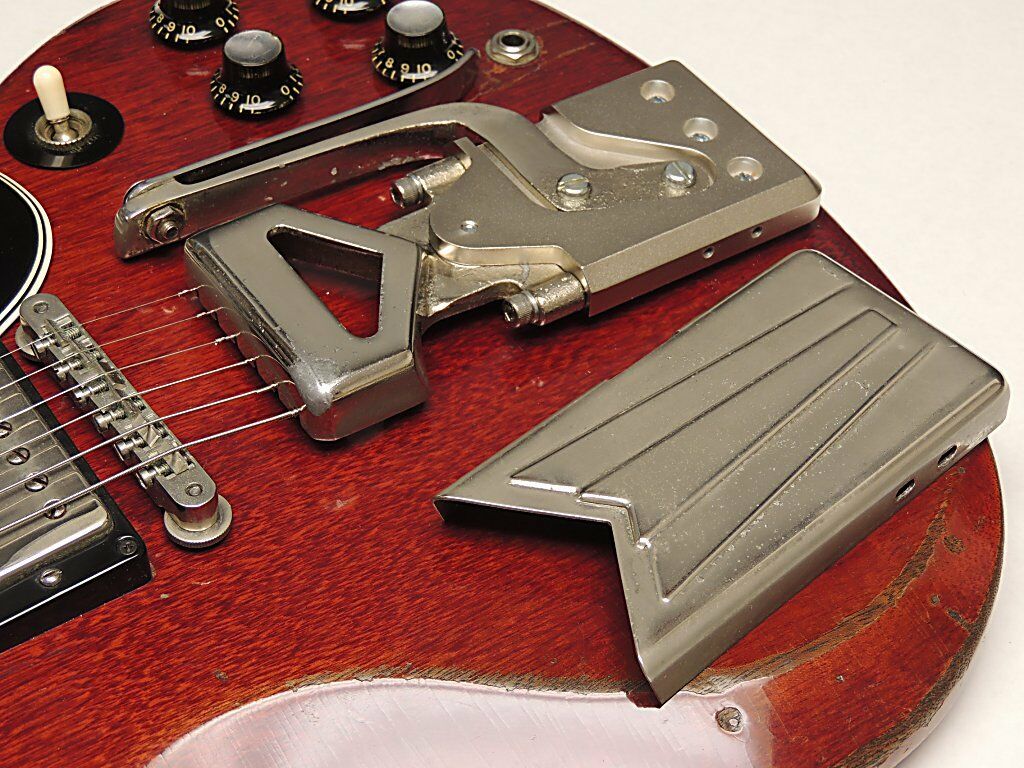
The design was described as simple but effective while drawing comparisons with Bigsby with which it shared its placement of assembly on the instrument’s belly. This made it particularly attractive for the mounting on both archtop and acoustic guitars. Yet, 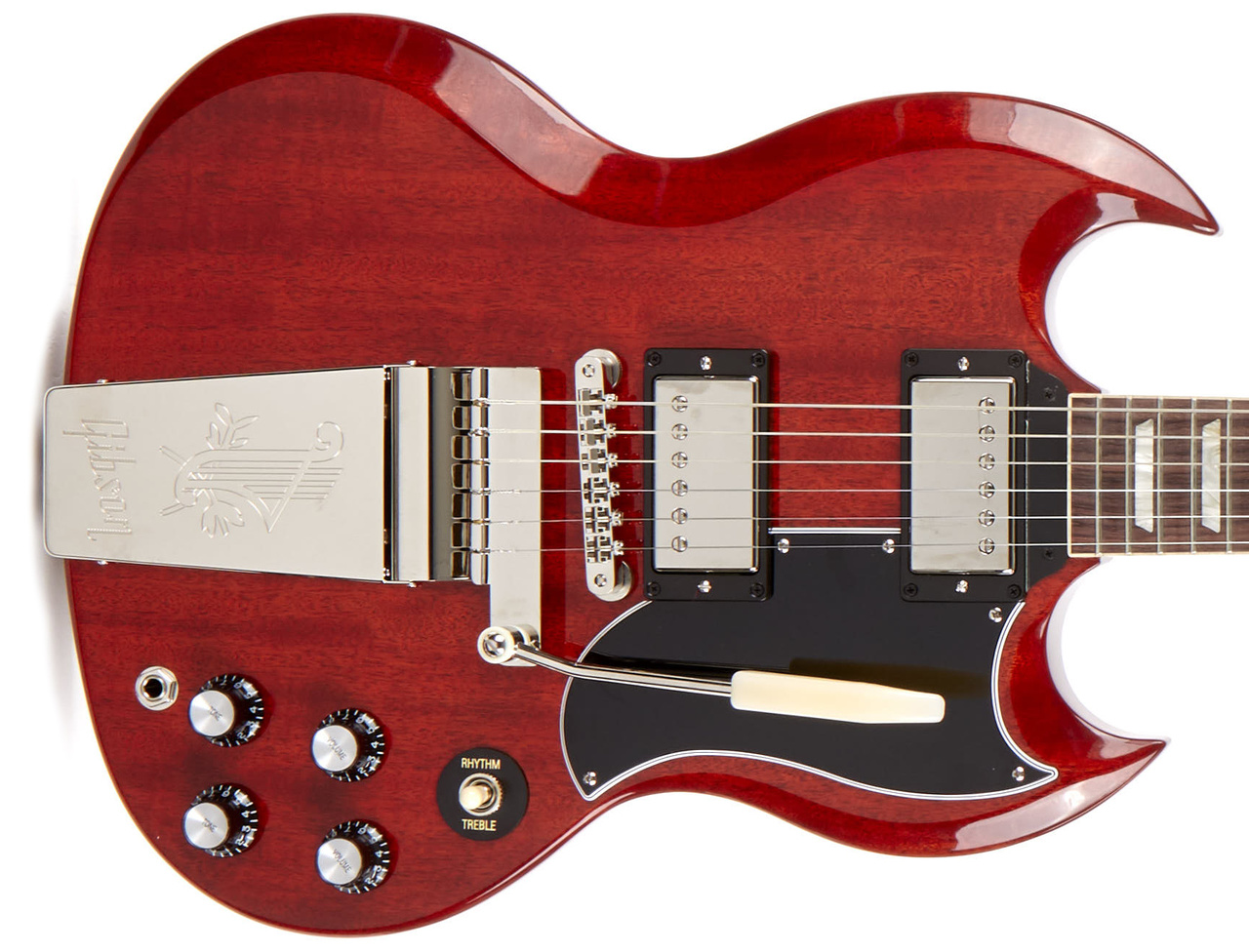
Contrary to what one could expect from an improved tremolo design, Gibson’s new solution went after the additional simplification of design, particularly in comparison with its competitors in the form of (primarily) Fender and Bigsby. At first sight, the system’s base resembled a piece of a slightly curved metal plate attached to the guitar with screws. Another component was a piece of metal that hosts both the tremolo arm and strings. This apparatus is placed on top of curved 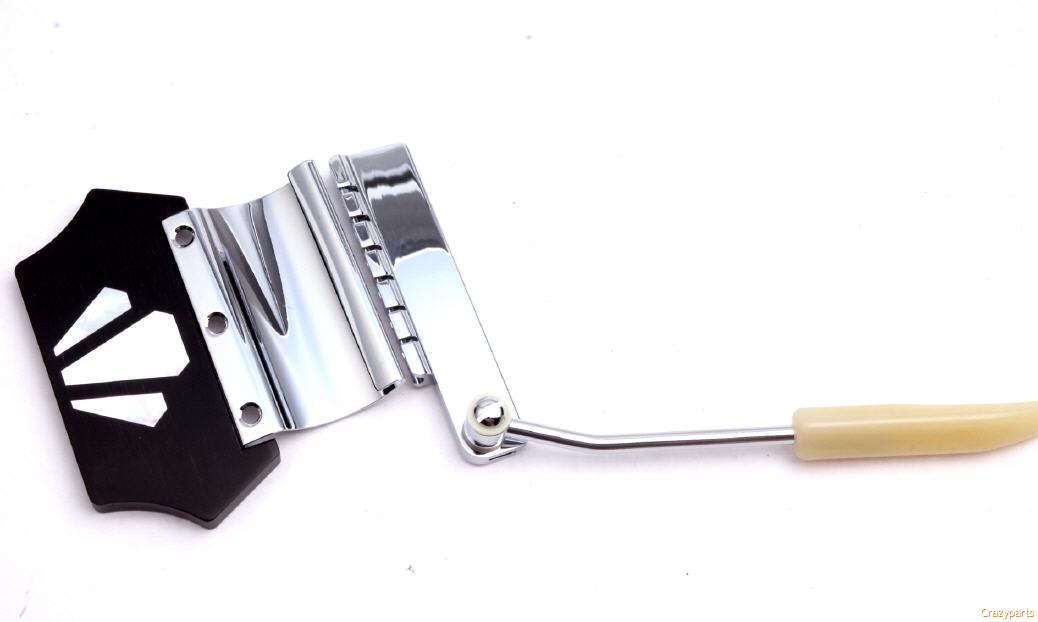
Gibson’s simple but efficient tremolo design failed to impress many players, stemming from two key trends at the time. One was competition, but the other traced to fickle pop and rock tastes that pushed players to seek more daring sounds from their instruments. Gibson tremolo was simply ill-equipped to respond to the demands of faster and heavier guitar acrobatics, which Fender’s guitars could handle much better. Paired with high prices of both its standard and limited edition models, Gibson’s additions to the guitar history were slowly relegated to the ranks of collectors and one-of-the-kind players such as Eric Clapton.
While both Fender and Gibson offered their solutions to some of the problems which plagued players in the 1960s, their tremolo workshop elves soon had to contend with a revolutionary competitor that threatened to blow everyone out of the water.
Raising the Bar: The Floyd Rose Tremolo Revolution
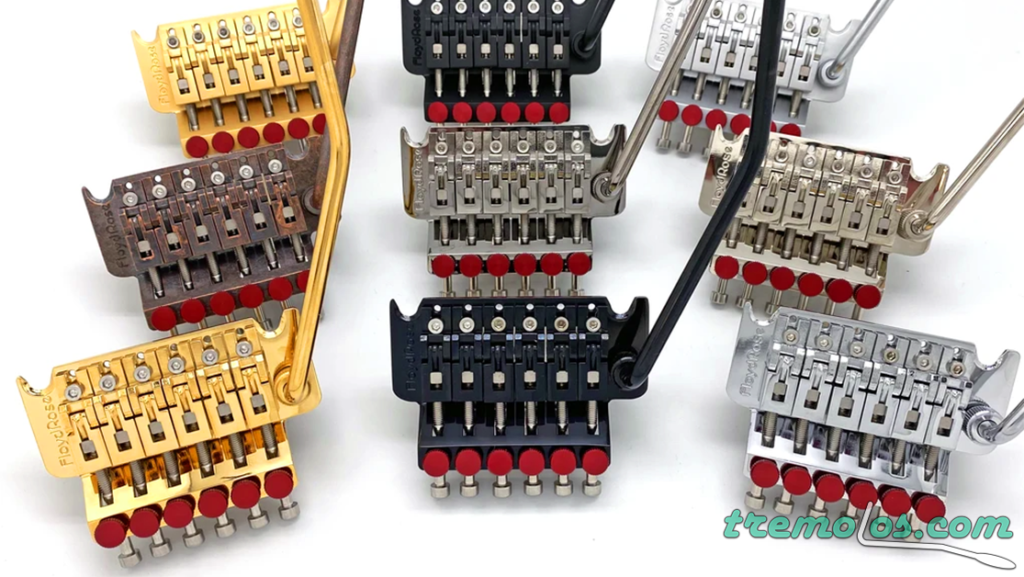
1977 was the historical and musical environment in which Floyd Rose sat down at the drawing table to design a tremolo that could offer technical robustness in the face of increasingly aggressive and restless treatment of this piece at the hands (literally) of guitar players. It was on a cold evening, after an exhausting rehearsal session in his icy storage unit, that Floyd spotted a peculiar thing on his guitar. With the tremolo arm depressed, the windings on the E string would slide over the nut. So he marked the string at the nut and then dove tremolo arm, to see if indeed, this would cause the string to be displaced. Even the smallest nudge on the arm would displace the string from its starting position causing tuning problems. Floyd put a dab of Krazy Glue on the nut and string to control this displacement and to his surprise, it worked! This confirmed his theory that some sort of locking mechanism at the nut could solve a host of tuning problems. So off to work he went.
He was lucky to be working as a jewelry maker at the time, so he had all the necessary tools to turn his ideas into fruition. Using a lapidary rig, he managed to create a thin brass nut with three U-shaped clamps, helping the strings stay fixed. He drilled two holes in the neck of his 1963 Fender Stratocaster, just beneath the nut. It was a huge risk to try something like that on a vintage guitar especially because the neck on that guitar was from a 57 Strat!
The experiment paid off, and the locking system was solid – as long as you didn’t squeeze the tremolo arm too hard. Soon after, his parents lent him $600 to have the second version built in a shop, and that is what Floyd calls the first real Floyd Rose Tremolo Locking System. But there was a problem – the materials used weren’t strong enough.

Nevertheless, with Eddie on board, this allowed the Floyd Rose Tremolo Locking System to skyrocket in popularity, to patent-protect the invention, and start mass production with Kramer. 6 prototypes were made by Floyd himself sometime around 1979-1980 and given to other well-known guitarists of that time such as Brad Gillis (Night Ranger) and Neal Schon (Journey) to name a few. The first guitarist to experiment with FTR-1 is believed to be Seattle based player and Jimi Hendrix tribute artist Randy Hansen. In 1981, the FRT-1 tremolo went into full production, manufactured by Japanese guitar company Fernades. Check out vintagefloydrose.com for some great historical content.
The Floyd Rose tremolo has undergone many improvements and redesigns over the years, yet its core principle and iconic look have remained unchanged. This bulletproof design has withstood the test of time, making it one of the most licensed, produced, and replicated tremolo (vibrato) systems of all time.
6 Slick Whammy Tricks
At the same time, the pitch could be easily changed with the help of Floyd Rose’s floating mechanism which ensured that the bridge remains a “floating” element in the tension interplay between the springs and strings. Finally, with the strings under the lock and key at two key zones on the instrument, guitarists could abuse the tremolo without remorse, allowing for the proliferation of the famous associated techniques such as dive bomb, reverse dive bomb, elephant noise, slide, scoop and doop and many others. Read more on Do Tremolo Springs Really Make A Difference? A Guide Exploring Their Effect On Performance And Tone.

In January 1991, Kramer’s exclusive distribution agreement with Rose ended when Fender announced they would be the new exclusive distributor of Floyd Rose products. In 2005, distribution of the Floyd Rose Original reverted to Floyd Rose and is now exclusively manufactured and distributed through AP International, owned by former Kramer employee Andy Papaccio. Floyd Rose continues to innovate new systems including the FRX surface mount tremolo for Les Paul or tune o matic style guitars and the popular hybrid tremolo Rail Tail which is a direct swap retrofit for 6 point Stratocaster style guitars.
Fender's Misstep: A Costly Blunder
2 years before Floyd Rose and Kramer would cozy up, Floyd sent a handwritten letter and audiotape to Fender in 1977 explaining his idea. as stated in this letter: “So you can hear for yourself that the guitar stays in perfect tune no matter how harshly tremolo bar is used.” Fender’s response: “At present, we have no use for this idea.” Needless to say, Fender ultimately passed on the idea. Oops! It makes you wonder what would have happened if they jumped on board. It most likely worked out for the best, as many big corporations shelve products after a few years, which could have left Mr. Rose high and dry or tied up in some nasty legal battle.
The Awkward Split as Kramer and Floyd Cozy up
It would be challenging to discuss tailpieces without acknowledging the contributions of German pioneer and inventor Dieter Gölsdorf. Of particular note is the Rockinger Tru Tune Tremolo, invented by Gölsdorf, which also played a significant role during this period.
Kramer guitars were fitted with the Tru Tune system before the Floyd Rose tremolos. In early Kramer literature and product tags, the Rockinger tremolo was referred to as the “Edward Van Halen Tremolo” although EVH always expressed his frustration with the tremolo and suggested improvements that the folks at Rockinger didn’t take too well. In the meantime, EVH had been working with Floyd Rose and eventually, the Floyd Rose tremolo system took over as the preferer tremolo for the Kramer brand. The Rockinger was available through 1982.)
Dieter would go on to invent many other systems including the LesTrem. 1986 he founded Duesenberg Guitars. It is Dieter Gölsdorf’s very own interpretation of the Art Deco style, which gives the instruments their distinctive appearance.
Kahler's Quest to dethrone the King
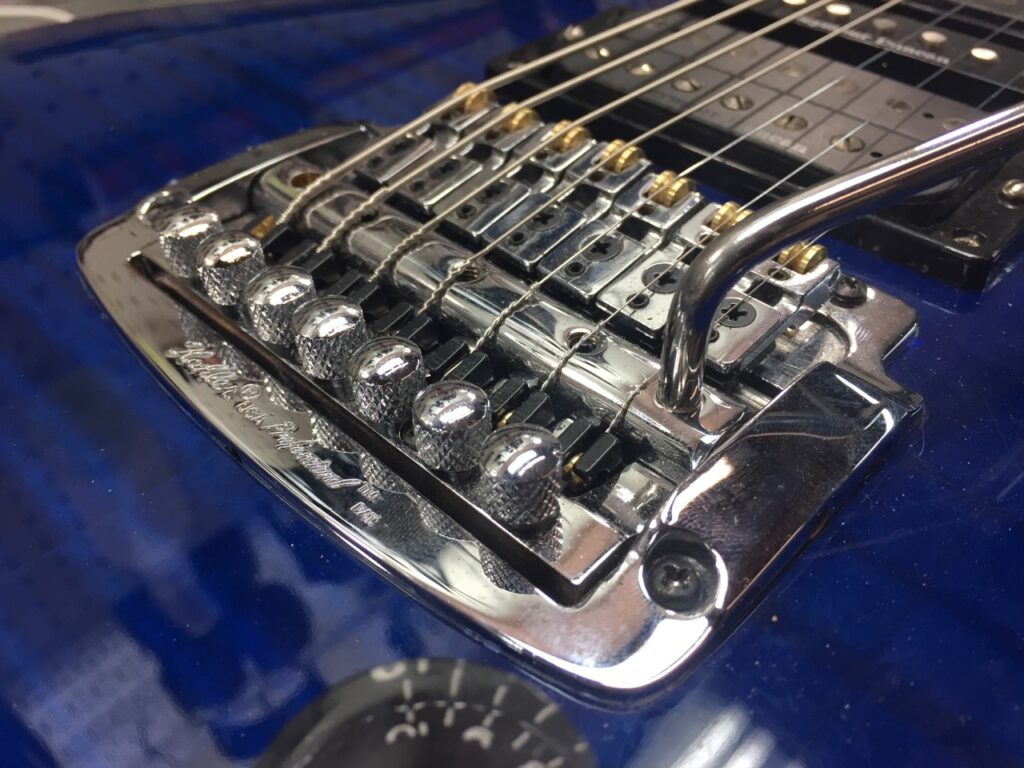
Ten years after renaming his company American Precision Metalworks, Kahler designed and launched the Kahler tremolo system. Clearly inspired by Floyd Rose, it incorporated a locking nut and fine tuners on the bridge that closely resembled Floyd’s design. This similarity led the court to find Kahler guilty of patent infringement. However, Kahler’s tremolo did feature some original elements, including a cam-based system where the strings attached to a single cylindrical cam inside the bridge housing. Additionally, Kahler’s system allowed guitarists to use strings with intact ball ends.
However, when Floyd Rose won a patent lawsuit against Kahler, it tipped the scales in Floyd Rose’s favor. Fast forward to 2005 – Kahler began licensing Floyd Rose’s patented design and has since produced over one million licensed tremolo systems. Floyd Rose and Kahler were fierce competitors in the 1980s, much like Samsung and Apple today. With many famous guitarists endorsing one brand or the other, the battles between Floyd vs Kahler within guitarists still rages on.
How the Floyd Rose and Kahler tremolos differ
Design:
Floyd Rose Tremolo: The Floyd Rose tremolo typically features a locking nut at the headstock of the guitar, locking the strings in place to enhance tuning stability. It also utilizes a double-locking system at the bridge, where both the strings and the bridge are locked down to maintain tuning stability, even with heavy tremolo use.
Kahler Tremolo: The Kahler tremolo, on the other hand, often employs a cam-operated design. It utilizes a cam mechanism to pivot the bridge, allowing for tremolo movement while maintaining stability. The strings are typically not locked at the nut, but the Kahler bridge design aims to compensate for this with its tremolo system.
Operation Mechanism:
Floyd Rose Tremolo: The Floyd Rose tremolo utilizes a balanced tension system in which it pivots on two posts via hardened, knife-like edges. The tension of the springs inside the guitar’s back cavity counterbalances the string tension, allowing the bridge to return to its original position after use. This helps maintain the guitar’s tuning stability when using the tremolo system.
Kahler Tremolo: The Kahler tremolo uses a cam mechanism to pivot the bridge, allowing for tremolo movement. The design aims to minimize friction and provide smooth operation while maintaining tuning stability.
Honorable Mention: Trev Wilkinson and the Pursuit of Perfection
Trev Wilkinson is a renowned British designer and innovator, widely recognized for his contributions to the world of guitar hardware and tremolo systems.
One of Wilkinson’s most notable innovations is the VS100N tremolo system, which he introduced in the late 1980s. The VS100 combines precision engineering with innovative design features to provide guitarists with exceptional tuning stability and smooth tremolo action. Trev Wilkinson partnered with Gotoh, a leading Japanese guitar parts maker, to design various guitar components like bridges, tuners, and tremolo systems. Combining Wilkinson’s guitar design talent with Gotoh’s manufacturing excellence yielded top-notch products used globally by guitarists.
Wrap up
The journey of the Tremolo, vibrato or even whammy bar through history is a testament to the innovation and creativity of guitarists and inventors alike. From its humble beginnings as a simple tremolo attachment in the late 19th century to the iconic Floyd Rose Locking Tremolo system of the late 20th century, the tremolo bar has undergone numerous transformations, each reflecting the evolving needs and desires of musicians.

The tale of tremolo (or vibrato if you prefer ) is a fascinating chapter in the pop & rock saga, in which a piece of technology, human skill, and sonic art come together in an undulating vortex of sound and innovation. With so many different tremolo design variations and options out there, one can only ask, is there room for another better mousetrap? To the inventor, creator, or sonic artist trying to solve a problem they might not even have, the answer is always yes!

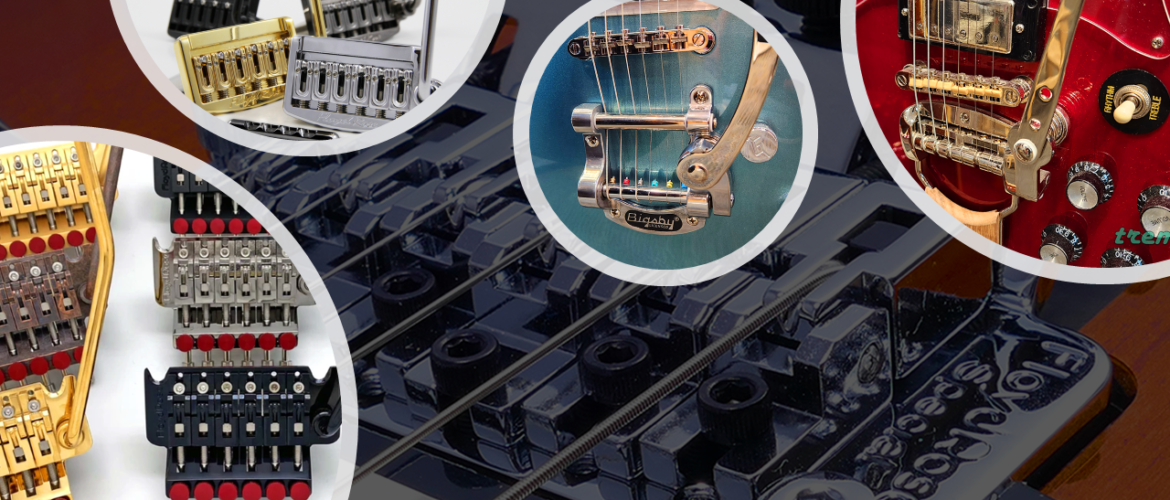

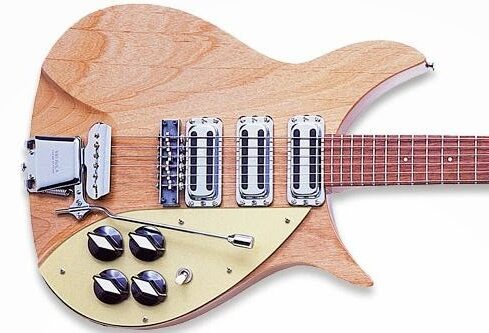
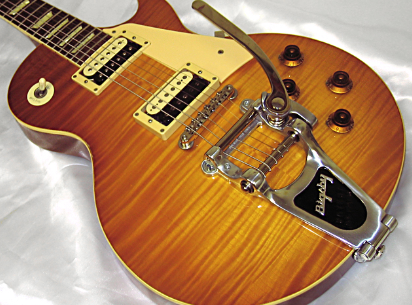
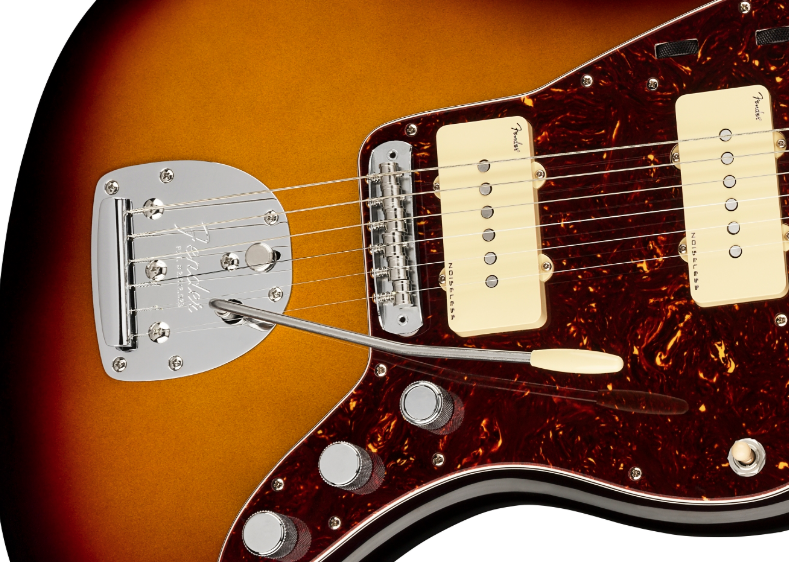
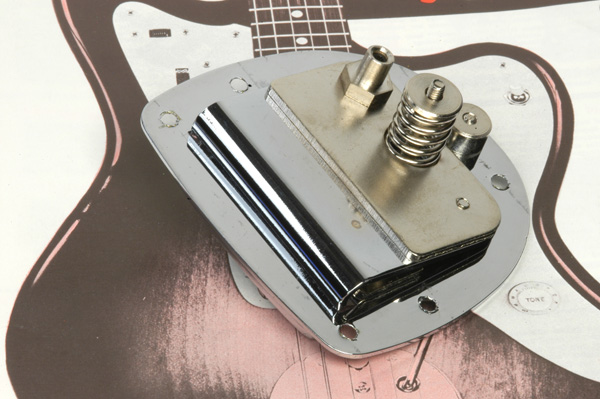



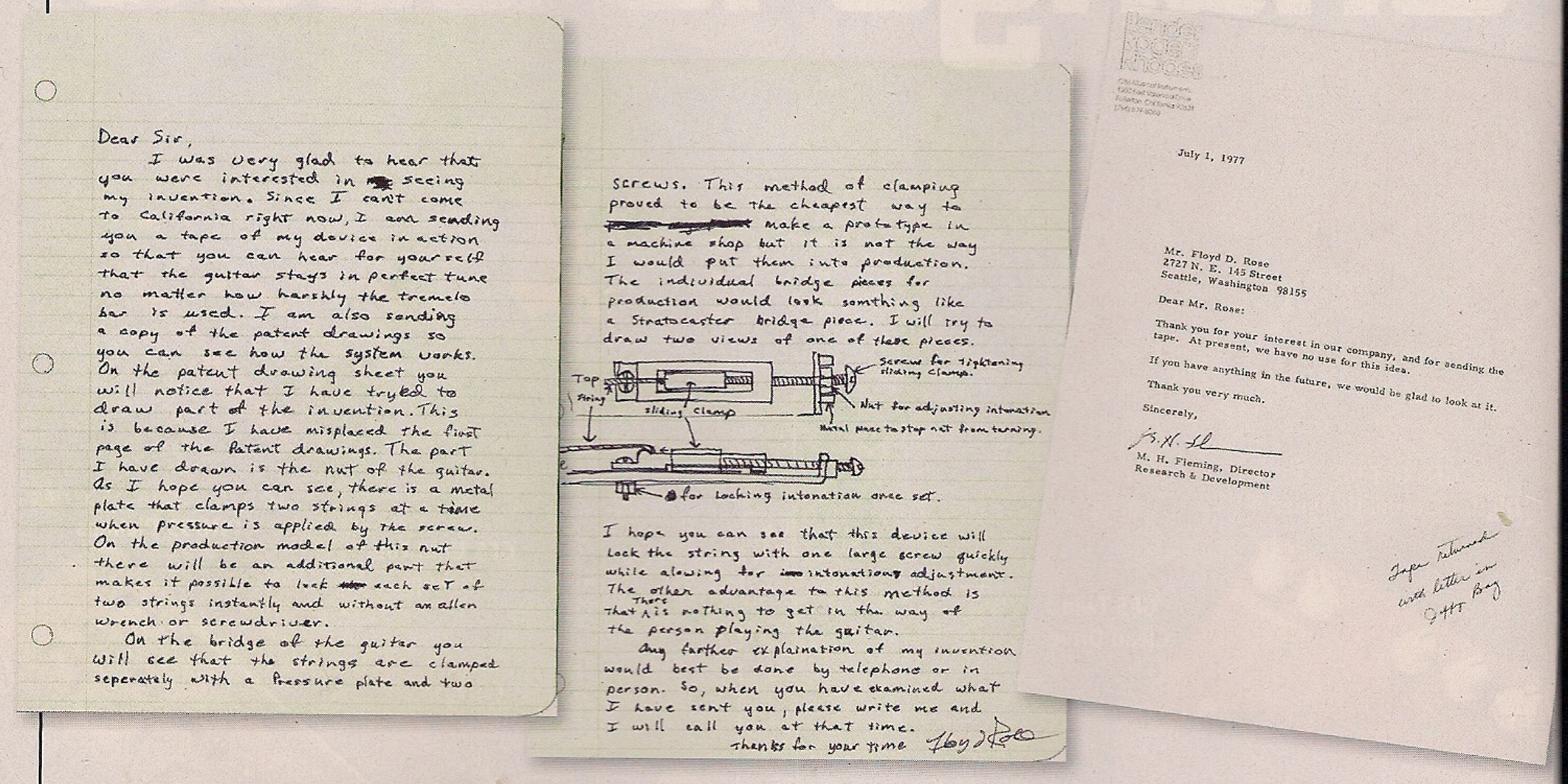
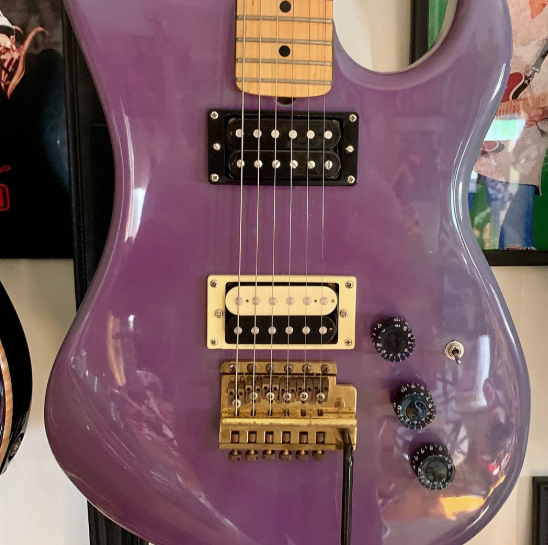

Fascinating read, well put together! I didn’t know about the Eddie and rockinger part.